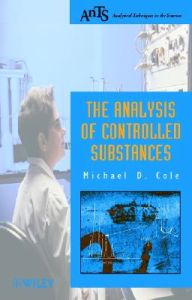
endast ny
The Analysis of Controlled Substances Upplaga 1
This series of books provides coverage of all of the major analytical techniques and their application in the most important areas of physical, life and materials science. Each text is presented in an open learning/distance learning style, in which the learning objectives are clearly identified. The reader's understanding of the material is constantly evaluated by the use of self-assessment and discussion questions. Series Editor: David J. Ando It is now recognized that, in order to ensure the validity of a forensic science analysis, a number of criteria need to be met. These include the following: *The sample under investigation is suitable for the analysis being carried out. *The analytical procedure adopted will answer the particular question(s) being asked, for example, with respect to identification, quantification and profiling (comparison of samples). *The data obtained are both correctly recorded and interpreted. *The findings are accurately reported. The aim of this text is to provide an understanding into the analysis of drugs of abuse within the context of their control, an appreciation of the different techniques that can be employed for drug analysis and the reasons for their use. In this book, the major classes of drugs of abuse are addressed, the analysis of which follows a systematic framework, including description, presumptive testing, thin layer chromatography, instrumental methods and data analysis. Throughout the text, regular questions and answers are used to further develop an understanding of the processes being employed. This book will appeal to both undergraduate and postgraduate students of forensic science, as well as those practitioners who are new in post or receiving additional or refresher training. It should also be of benefit to those who are studying controlled substances as broadening courses in other scientific disciplines.
Upplaga: 1a upplagan
Utgiven: 2003
ISBN: 9780471492528
Förlag: John Wiley & Sons
Format: Inbunden
Språk: Engelska
Sidor: 214 st
This series of books provides coverage of all of the major analytical techniques and their application in the most important areas of physical, life and materials science. Each text is presented in an open learning/distance learning style, in which the learning objectives are clearly identified. The reader's understanding of the material is constantly evaluated by the use of self-assessment and discussion questions. Series Editor: David J. Ando It is now recognized that, in order to ensure the validity of a forensic science analysis, a number of criteria need to be met. These include the following: *The sample under investigation is suitable for the analysis being carried out. *The analytical procedure adopted will answer the particular question(s) being asked, for example, with respect to identification, quantification and profiling (comparison of samples). *The data obtained are both correctly recorded and interpreted. *The findings are accurately reported. The aim of this text is to provide an understanding into the analysis of drugs of abuse within the context of their control, an appreciation of the different techniques that can be employed for drug analysis and the reasons for their use. In this book, the major classes of drugs of abuse are addressed, the analysis of which follows a systematic framework, including description, presumptive testing, thin layer chromatography, instrumental methods and data analysis. Throughout the text, regular questions and answers are used to further develop an understanding of the processes being employed. This book will appeal to both undergraduate and postgraduate students of forensic science, as well as those practitioners who are new in post or receiving additional or refresher training. It should also be of benefit to those who are studying controlled substances as broadening courses in other scientific disciplines.
Ny bok
2439 kr2567 kr
5% studentrabatt med Studentapan
Begagnad bok (0 st)
Varje vecka tillkommer tusentals nya säljare. Bevaka boken så får du meddelande när den finns tillgänglig igen.



